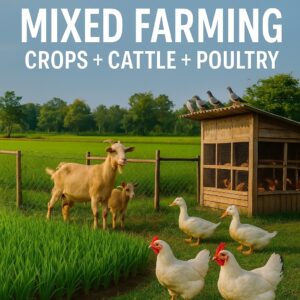In today’s world of smart agriculture, mixed farming is one of the most effective and sustainable methods to maximize profits, reduce waste, and improve soil fertility. It involves combining crop cultivation, livestock rearing, and poultry farming in one integrated system.
Let’s explore how to implement mixed farming on your land or farmhouse efficiently — especially in rural areas where space and resources are limited.
What is Mixed Farming?
Mixed farming means growing crops and rearing animals (like cows, goats, poultry, etc.) on the same land or in the same farming system. It promotes interdependence between components — for example, animal manure improves crop yields, and crop waste can be used as animal feed.
✅ Benefits of Mixed Farming
-
Reduces dependency on one source of income
-
Reuses waste (manure, feed leftovers, crop residues)
-
Saves water and fertilizer
-
Increases profit margins with lower input costs
-
Promotes ecological balance and sustainability
Core Components of Mixed Farming
1. Crops
-
Rice, maize, wheat, vegetables
-
Crop rotation improves soil and pest control
2. Livestock
-
Goats, cows, sheep
-
Milk, meat, manure = daily income
3. Poultry
-
Chickens, ducks, quails
-
Fast-growing, small space needed
Integration ensures that each part supports the other — manure goes to crops, crop waste feeds livestock, etc.
Farm Layout Example for Small Farmers
| Section | Area Required (1 Acre Farm) |
|---|---|
| Crop Zone | 60% |
| Goat/Cow Shed | 20% |
| Poultry House | 10% |
| Compost Area | 5% |
| Water + Storage | 5% |
✅ Design walkways and drainage to avoid mixing waste with water sources.
Best Practices for Mixed Farming Success
1. Compost Management
-
Use goat/cow dung to make compost
-
Add poultry litter for nitrogen boost
-
Apply organic compost to crop fields
2. Feed Planning
-
Crop leftovers (maize husk, straw) feed goats and cows
-
Chickens eat insects and grains from the fields
-
Use duck farming in rice paddies (they eat pests!)
3. Rotation & Integration
-
Rotate crops like rice → pulses → vegetables
-
Use goats to graze on post-harvest fields
-
Ducks control insects in wet fields
Profit Calculation (Example)
| Component | Expected Monthly Income |
|---|---|
| 100 broiler chickens | $250–300 |
| 3 dairy cows (milk) | $200–250 |
| Seasonal vegetable crops | $150–200 |
Higher than doing any one activity alone
Tools & Equipment Needed
-
Compost bin or pit
-
Water tank with channels
-
Separate sheds for animals
-
Feed storage containers
-
Small tractor or power tiller (optional)
Challenges & Solutions
| Challenge | Solution |
|---|---|
| Manure smell | Regular cleaning & composting |
| Disease transfer | Keep livestock and poultry separately |
| Resource management | Keep logs of feed, water, waste use |
FAQs
Q1: Is mixed farming good for small farmers?
Absolutely. It lowers risk and increases income even with limited land.
Q2: Can poultry and goats be raised together?
Yes, but keep them in separate sheds to avoid disease transfer.
Q3: How much land is needed?
Even 0.5–1 acre is enough to run a small mixed farming setup.
Coming Up Tomorrow:
“Fish Farming in Rural Areas: How to Start and Earn from a Backyard Pond”



